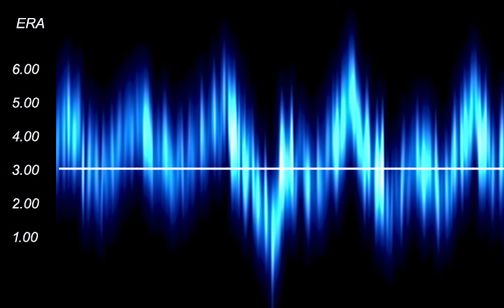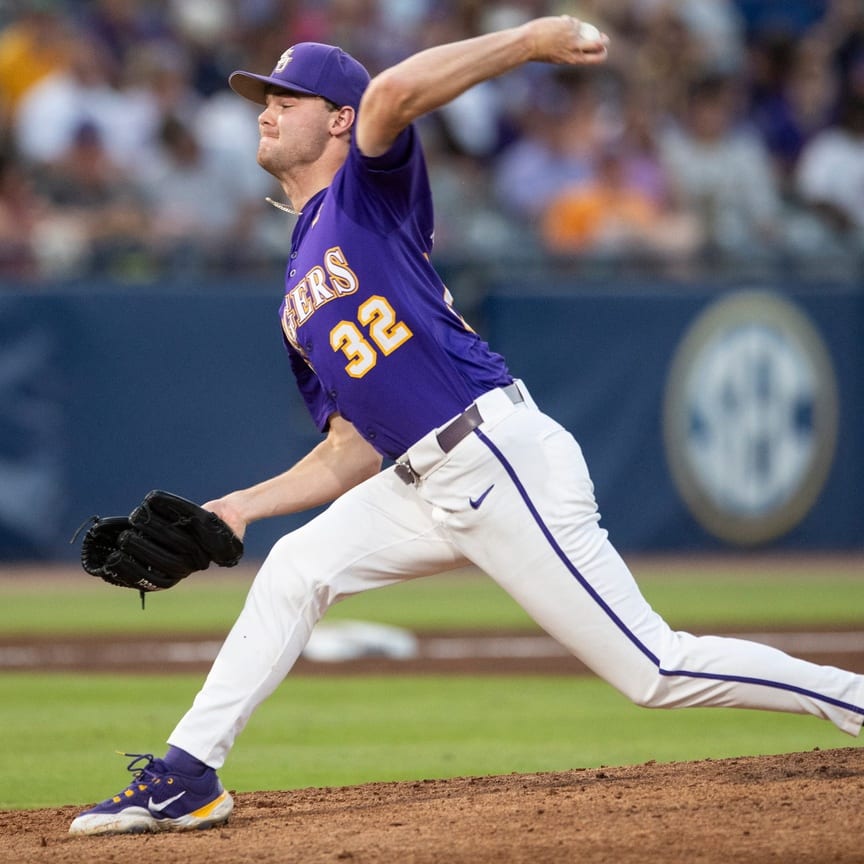A couple weeks ago I delved into matchup pitching decisions. It has always been a critical part of fantasy team management, but with the growing disparity in team talent, I feel like it's more impactful than ever. This week we'll take a look at another angle. Every human – including MLB pitchers – goes through ups and downs in performance. We all realize (or should realize) that a starting pitcher who comes out blazing with a sub 1.00 ERA will not end the season with that stat. Conversely, a good starting pitcher who stumbles out of the gate and ends the first month with a bloated 7.00 ERA will likely, assuming good health, bring that down to an appropriate level. A solid ERA of say, 3.00, does not typically come from two earned run over six innings every start. There will be good and there will be bad. So how can this help with managing your staff?
A few years back I decided to test a theory that the good and bad outings might be somewhat predictable. I took a representative sample of starting pitchers including a wide range of expectations from aces to cannon-fodder, and plotted their outings on a graph. I used a five-point rating with five being a dominant start, four being a good start, three being mediocre, two being sub-par, and one being a train wreck. If a pitcher experienced an injury, I threw that pitcher out as probably providing flawed data. I wanted to see
A couple weeks ago I delved into matchup pitching decisions. It has always been a critical part of fantasy team management, but with the growing disparity in team talent, I feel like it's more impactful than ever. This week we'll take a look at another angle. Every human – including MLB pitchers – goes through ups and downs in performance. We all realize (or should realize) that a starting pitcher who comes out blazing with a sub 1.00 ERA will not end the season with that stat. Conversely, a good starting pitcher who stumbles out of the gate and ends the first month with a bloated 7.00 ERA will likely, assuming good health, bring that down to an appropriate level. A solid ERA of say, 3.00, does not typically come from two earned run over six innings every start. There will be good and there will be bad. So how can this help with managing your staff?
A few years back I decided to test a theory that the good and bad outings might be somewhat predictable. I took a representative sample of starting pitchers including a wide range of expectations from aces to cannon-fodder, and plotted their outings on a graph. I used a five-point rating with five being a dominant start, four being a good start, three being mediocre, two being sub-par, and one being a train wreck. If a pitcher experienced an injury, I threw that pitcher out as probably providing flawed data. I wanted to see if a pitcher's biorhythm could be at least partially tracked.
The results were interesting. Most pitchers headed one direction or the other from their starting point. Some declined and others improved, but there were some pretty clear trends. Not surprisingly, the better pitchers experienced higher peaks of longer duration with fewer valleys, which often rebounded fairly quickly. The poor pitchers were just the opposite. There were, of course, some extenuating circumstances like strength of opponent, etc., but I decided to generally ignore those as being too arbitrary.
I actually found that while certainly not guaranteed, pitchers with a positive trending graph usually did well in their next start, while a pitcher trending down often struggled in their next outing. As you might expect, the better pitchers were also more predictable, primarily because they were more consistent, but even the weaker pitchers did show trending results. A good pitcher with a 3-3-4-3-4 graph over their last five starts usually posted a strong start in their next outing. Conversely, a chart of 5-4-3-3-2 often forewarned of a coming clunker. Sometimes a positively trending pitcher would toss in an ugly start, but rarely did a downward trending guy throw an unexpected gem.
A visual depiction of biorhythm – I'll toss in a little graphic that I believe illustrates the trending tendencies of many major league starting pitchers; when they might be ripe for the picking and when storm warnings are probably up. If you anticipate your pitcher generating a 3.00 ERA, and the plot starts along that line, you will probably find the starts are above or below the target ERA. A five start would be near the bottom of the chart while a one outing would be near the top. For example, I plotted the 13 2022 outings of Carlos Rodon, one of my starters, and found that his starts produced a line of 4-5-4-4-3-3-1-3-2-4-4-4-4-5. It would seem to predict that his disaster start of May 15 (the 1) was coming, and his recent gem on June 17 (the last five) was not a surprise.


I also looked at a handful of other pitchers to see what their trends indicated. The Rangers' Jon Gray showed a positive trend and looked very good in his start against Detroit last week. Notably, the White Sox' Dylan Cease is displaying a very positive trend, and he may be about to toss a gem or two. Then, on the flip side, the Blue Jays' Kevin Gausman appeared to be on a downswing a couple weeks ago, and the Yankees' Nestor Cortes might be starting to trend downward. Of course, there are plenty of outliers. Gerrit Cole's recent trending is 3-4-2-4-5-1-5. The general trend was positive, but that disaster in Minnesota on June 9 came out of nowhere. I think I'd avoid whatever he had for breakfast that morning.
As you know, pitching is a series of adjustments. The pitcher, especially a young pitcher, has an advantage early on, in most cases, as the hitters lack familiarity with the repertoire. However, after a handful of starts, the results start to suffer. The hitters are learning. Ongoing success depends greatly on the pitcher being able to adjust to those hitter evolutions, and the whole process repeats. If the pitcher can't adjust, he typically fades into oblivion – at least until he is more seasoned and better prepared.
How many times have you seen a pitcher roll through a few early starts, and immediately after you grab him, the wheels seemingly come off and he is annihilated in his next few outings? Or, in our case study here, you go to the wall at next spring's draft to grab the hottest commodity at the table – the infamous "buzz" guy – You look good, as he starts the season well, only for you to watch him get battered during late April before a trip back to the minors in mid-May. The pitcher likely progressively dipped along the graph before imploding.
Some indicators of likely success (or failure) – Next, we'll pull things together and hopefully build a predictive model to determine which pitchers are most likely to succeed in the near future. I would note, even though it isn't easy to quantify, I will give a little extra credit for positive performance against a stronger opponent.
- High-ceiling pitchers with good command and three (or more) quality pitches – Rather obviously these are the best bets for success now and later. Don't just look at runs allowed in each start. Is their command wavering? Are they missing fewer bats, or is their hard-hit rate on the rise? These can be predictors of a tough stretch coming. If their performance is these areas is trending in a positive direction, better times ahead are a likely result.
- Lower-ceiling pitchers with a very deceptive motion and decent command, but a limited repertoire – Deception is the key here. When a starting pitcher features a deceptive delivery, hitters often struggle against them at first. However, it rarely lasts. They might do very well when they first come up – hopefully throughout the month – but they are extremely risky plays for the future when batters will become more familiar with that deceptive motion.
- Moderate- and even high-ceiling pitchers with inconsistent command of more than one or two pitches – In almost every scenario, starting pitchers will eventually live or die with their command of the strike zone. The higher the upside, the more likely they are to succeed, at least for a while, but hitters will begin to lay off secondary pitches and focus primarily on their fastball. That is not a formula for success. The high-ceiling guys still warrant monitoring, as they could become long-term success stories if/when they develop more consistency, but there is considerable risk until that happens.
Some Notable Rotation Ramblings:
- One of my favorite things to see in a MLB baseball game is an "immaculate inning" – three strikeouts on nine pitches. It's like hitting for the cycle to a pitching junkie. Last week, Houston's Luis Garcia and Phil Maton did it twice in one game! In all my years following baseball I have never seen that happen before.
- Andrew Heaney may be finding new life with Los Angeles. He missed two months with a shoulder injury but looked very sharp in his first start back before tiring a bit in his sixth inning of work. If he can keep that shoulder glued together, he can help the Dodgers (and a fantasy team) in the second half.
- The minor knee issues he experienced might be slightly sapping the power of Chicago's Michael Kopech. In his last start, his velocity was down a bit, and he relied more on his off-speed pitches. In the long run this might actually help him as he is forced to diversify, and be more accurate in hitting his spots.
- I made it a point to watch the last start of Miami's Trevor Rogers, and I have to say I was pretty impressed. Despite a weak stat line (certainly not all his fault), his command was much improved, his breaking pitches were crisp, and he was mixing things up. I'm going to say better days are looking imminent for him.
- There was some speculation that the Red Sox might have Chris Sale pitch out of the bullpen to get him back sooner, but the plan is for him to join the rotation after he completes his rehab. He made his first rehab appearance earlier this week, tossing one inning. Early reports are that everything went well.
- One of the hottest buzz arms has been Atlanta's Spencer Strider. I'll start by saying I love his fastball and slider, but as I have been saying, putting him in the rotation presents a serious risk of overexposure with his two-pitch mix. He's going to have to show me something off-speed before I get on his bandwagon.
- I also hope you got to check out the MLB Draft Combine that took place last week. A couple interesting guys to keep track of are lefty Connor Prielipp (coming off Tommy John surgery but has potential ace stuff) and a genuine switch-pitcher, Jurrangelo Cijntje (he sits 95 right-handed, 93 left-handed).
Endgame Odyssey:
The amazing Josh Hader went on the paternity list last week, and the Brewers bullpen never missed a beat, posting zeroes the whole time he was gone. Opponents better get a lead before that pen gets involved. It looks like the Phillies are settling into a timeshare for saves. Several arms including Brad Hand have gotten chances, but I still believe when the dust settles, Seranthony Dominguez will be the main guy. The Mariners were finally able to activate Ken Giles (he hasn't pitched in a MLB game in almost two years). He has closing experience, but his rehab performance suggests he has a lot to prove before he is considered for ninth-inning work. The Dodgers Craig Kimbrel has not looked good for quite a while. One has to wonder if a ninth-inning change in closers to Daniel Hudson is being considered. It appears Boston has settled on Tanner Houck as its primary closer. He's not ideal, but that offense is likely to give him plenty of leads to try and protect.




































